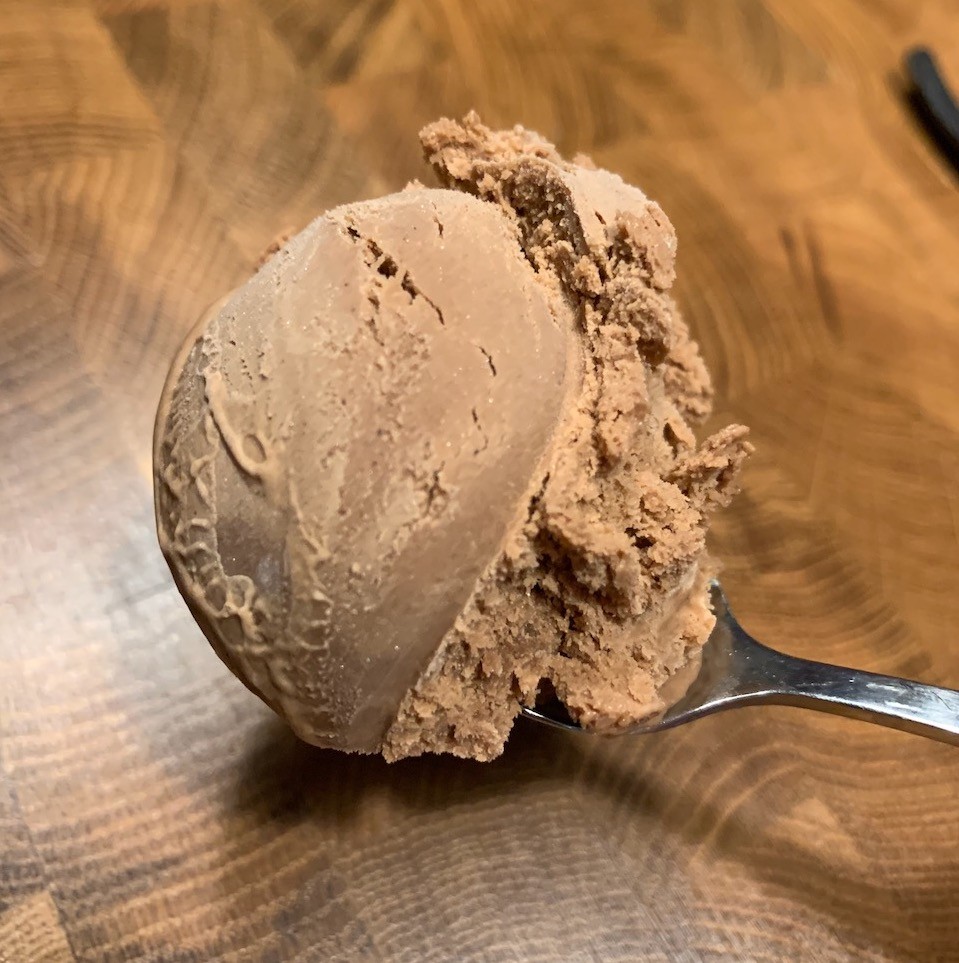For me, the magic ingredient of rich dark chocolate ice cream is cocoa mass. As cocoa mass does not contain any sugar, its a lot easier to control the sweetness of the ice cream. Cocoa mass does contain a lot of fat, so in the ice cream mixture, we need to compensate for this. In comparison to my vanilla recipe, this recipe has more milk and less cream.
This recipe uses my preferred technique of heating the ice cream base sous vide. More info on this technique can be found in my post on sous vide ice cream base. It is possible to make this ice cream without a sous vide setup by adjusting the recipe, see below for more information.
Update March 1, 2020: After some experiments, I have updated the recipe. The new recipe has an improved texture and flavour release, compared to the old recipe. The main differences are the ratio of cream, milk and chocolate, and adding a tiny amount of salt.
Recipe for sous vide dark chocolate ice cream
Ingredients
These ingredients results in 950 grams of ice cream base and is roughly the quantity needed for a single run of most ice cream machines.
- 525 grams double cream (35% fat)
- 77 grams whole milk (3.4% fat)
- 35 grams skim milk powder
- 152 grams sugar (I used unrefined cane sugar, regular sugar also works)
- 86 grams egg yolks
- 76 grams cocoa mass
- 1 teaspoon vanilla extract
- 0.24 grams salt
Note on cocoa mass: The rich and non-sweet character of this ice cream is due to using cocoa mass instead of chocolate. I use cocoa mass from Callebaut, but it can be hard to find a supplier. Some alternatives are available through Amazon. If you cannot find cocoa mass, you can substitute it with high-cocoa chocolate (like 90%).
Equipment
- Emersion circulator. I use an Anova, but any brand will do.
- Vacuum pouches + sealer. I use a fairly cheap vacuum sealer from Foodsaver.
- Waterbath, can be a large pan or plastic container.
- Saucepan to heat the cream.
- Stick blender (optional, but will result in smoother ice cream).
- Ice cream churner, I use a Smart Scoop from Breville. Available as the Sage Smart Scoop in Europe.
Note on sous vide: This recipe can also be made non-sous vide if you have access to a food thermometer. Instead of heating the mixture in a water bath, heat the mixture on the stove and keep it for 25 minutes at 72 °C. Heating the mixture on the stove will result in more evaporation; to counter this, you can increase the amount of cream with 10%. I haven’t tested the non-sous vide version, let me know your results in the comments!
Steps
- Heat the water bath, set the circulator to 72 °C.
- Add milk and cream to the saucepan, heat until around 70 °C. Don’t let the mixture boil.
- Add the warm mixture to the chocolate, let the chocolate melt (about 1 minute).
- Emulsify the cream-chocolate mixture with the stick blender. Try to minimize bubbles forming. If you don’t have a stick blender at hand, you can skip this step and use a whisk. If skipping, there is a chance that some small cocoa mass chunks will be in the ice cream.
- Combine sugar, eggs and salt. Add milk powder. Mix well.
- Slowly incorporate the chocolate mixture into the eggs.
- Transfer the mixture to a vacuum bag.
- Seal the bag and add it to the water bath.
- Heat the mixture for 30 minutes at 72 °C.
- Remove the bag from the water bath and transfer to a bowl with ice water. Cool the mixture as fast as possible. You can also cool the bag under running water in the sink.
- Store the mixture in the bag in the fridge overnight.
- The next day, sieve the mixture and add one tablespoon of the vanilla extract by taste.
- Churn the ice cream according to the instructions of your ice cream machine.
- After churning, quickly transfer the ice cream to a pre-cooled storage container. Let the ice cream harden in the freezer, this takes roughly 3 hours.
